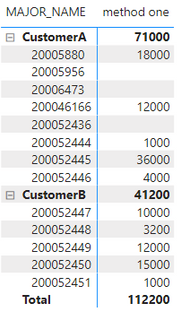FabCon is coming to Atlanta
Join us at FabCon Atlanta from March 16 - 20, 2026, for the ultimate Fabric, Power BI, AI and SQL community-led event. Save $200 with code FABCOMM.
Register now!- Power BI forums
- Get Help with Power BI
- Desktop
- Service
- Report Server
- Power Query
- Mobile Apps
- Developer
- DAX Commands and Tips
- Custom Visuals Development Discussion
- Health and Life Sciences
- Power BI Spanish forums
- Translated Spanish Desktop
- Training and Consulting
- Instructor Led Training
- Dashboard in a Day for Women, by Women
- Galleries
- Data Stories Gallery
- Themes Gallery
- Contests Gallery
- QuickViz Gallery
- Quick Measures Gallery
- Visual Calculations Gallery
- Notebook Gallery
- Translytical Task Flow Gallery
- TMDL Gallery
- R Script Showcase
- Webinars and Video Gallery
- Ideas
- Custom Visuals Ideas (read-only)
- Issues
- Issues
- Events
- Upcoming Events
The Power BI Data Visualization World Championships is back! Get ahead of the game and start preparing now! Learn more
- Power BI forums
- Forums
- Get Help with Power BI
- DAX Commands and Tips
- Re: Summing on multiple rows
- Subscribe to RSS Feed
- Mark Topic as New
- Mark Topic as Read
- Float this Topic for Current User
- Bookmark
- Subscribe
- Printer Friendly Page
- Mark as New
- Bookmark
- Subscribe
- Mute
- Subscribe to RSS Feed
- Permalink
- Report Inappropriate Content
Summing on multiple rows
Hi,
I am trying to create a measure that will sum my values based on two rows. My current formula is:
SUMX(VALUES(Table[customer]),Table[Price Variance])
What i actually need is for the measure to sum the price variance based on the product within each customer. If I put produt in the SUMX formula then it disregards the customer and if i put customer then it doesn't take into account the product. Is there a way to tell it to consider both?
Below is kind of what i am getting. The product numbers are right but then it summarizes it on customer so that one is wrong. I need it to say $20.
Customer Name $30
Product A $10
Product B $10
Hope this makes sense.
Solved! Go to Solution.
- Mark as New
- Bookmark
- Subscribe
- Mute
- Subscribe to RSS Feed
- Permalink
- Report Inappropriate Content
@chenko90 , This only need when Price Variance is measure
SUMX(summarize(Table, Table[Product], Table[customer]), "_1", Table[Price Variance]), [_1])
when price variance is a column
SUMX(summarize(Table, Table[Product], Table[customer], Table[Price Variance]), [Price Variance])
If this does not help
Can you share sample data and sample output in table format? Or a sample pbix after removing sensitive data.
- Mark as New
- Bookmark
- Subscribe
- Mute
- Subscribe to RSS Feed
- Permalink
- Report Inappropriate Content
Hi @chenko90 ,
I created some data:
Here are the steps you can follow:
Method one:
Create measure.
method one =
var _1=SUMMARIZE('Table','Table'[MAJOR_NAME],'Table'[SKU],'Table'[Price Vanriance])
return
SUMX(_1,[Price Vanriance])Result:
Second method :
Create measure.
second method_1 =
IF(ISINSCOPE('Table'[MAJOR_NAME])&& NOT(ISINSCOPE('Table'[SKU])),SUMX('Table',[Price Vanriance]),MAX('Table'[Price Vanriance]))second method_2 =
var _table=SUMMARIZE('Table','Table'[MAJOR_NAME],"_value",[second method_1])
return
IF(HASONEVALUE('Table'[MAJOR_NAME]),[second method_1],SUMX( _table,[_value]))Result:
Best Regards,
Liu Yang
If this post helps, then please consider Accept it as the solution to help the other members find it more quickly
- Mark as New
- Bookmark
- Subscribe
- Mute
- Subscribe to RSS Feed
- Permalink
- Report Inappropriate Content
Hi,
Typically a simple SUM should work in these kinds of cases, but I assume there is some issue with using it. Try adding DISTINCT before your VALUES so something like this:
I hope this post helps to solve your issue and if it does consider accepting it as a solution and giving the post a thumbs up!
My LinkedIn: https://www.linkedin.com/in/n%C3%A4ttiahov-00001/
Did I answer your question? Mark my post as a solution!
Proud to be a Super User!
- Mark as New
- Bookmark
- Subscribe
- Mute
- Subscribe to RSS Feed
- Permalink
- Report Inappropriate Content
Here is a visual of what im working with. As you can see the total for customer A is wrong. The sku level numbers are correct. When i use the SUM formula it has the same issue where it runs the formula in the measure instead of summing the sku level numbers.
- Mark as New
- Bookmark
- Subscribe
- Mute
- Subscribe to RSS Feed
- Permalink
- Report Inappropriate Content
@chenko90 , This only need when Price Variance is measure
SUMX(summarize(Table, Table[Product], Table[customer]), "_1", Table[Price Variance]), [_1])
when price variance is a column
SUMX(summarize(Table, Table[Product], Table[customer], Table[Price Variance]), [Price Variance])
If this does not help
Can you share sample data and sample output in table format? Or a sample pbix after removing sensitive data.
- Mark as New
- Bookmark
- Subscribe
- Mute
- Subscribe to RSS Feed
- Permalink
- Report Inappropriate Content
What does the "_1" mean?
Helpful resources

Power BI Monthly Update - November 2025
Check out the November 2025 Power BI update to learn about new features.

Fabric Data Days
Advance your Data & AI career with 50 days of live learning, contests, hands-on challenges, study groups & certifications and more!

| User | Count |
|---|---|
| 19 | |
| 10 | |
| 9 | |
| 4 | |
| 4 |
| User | Count |
|---|---|
| 31 | |
| 31 | |
| 20 | |
| 12 | |
| 12 |




